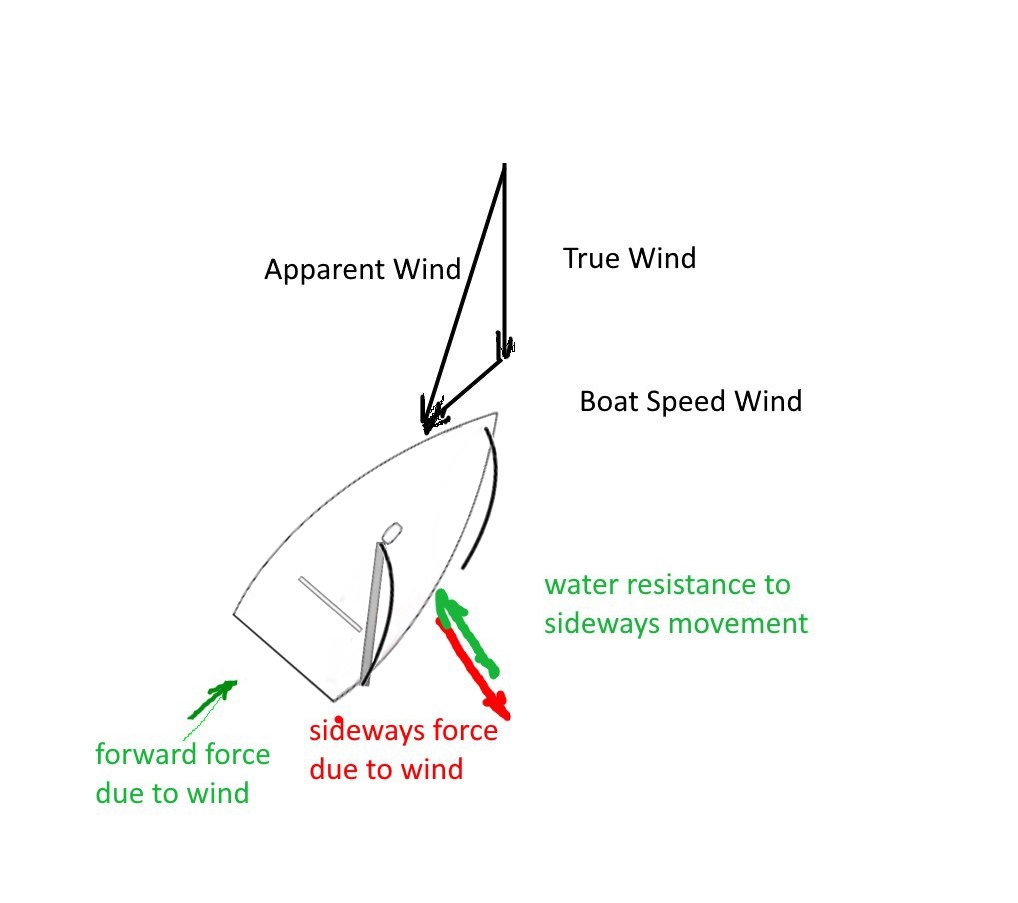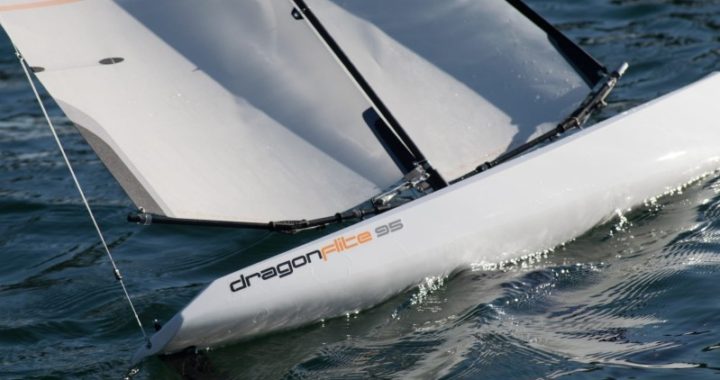Bit #1: How I Set Up my Boat
It will be useful for you later in this first Bit for you to understand how I set up my boat, in order for you to understand the important parts of the tuning I hope to describe. Please understand that I am not telling you that you should set your boat up as I do. Set your boat up the way you want it, but understand what you are doing.
For now we will confine our discussion to sailing upwind, hard on the wind, as close to into the wind as we can manage to arrive at the mark in the least time. This requires that we sail about 45 degrees away from directly into the wind. Since the boat is moving forward, the 'apparent' wind to the boat is the combination of the true wind and the wind caused by the boat's motion: the wind speed the boat sees will be higher, and the direction it comes from will move toward the bow.
Figure 1 shows the boat sailing at 45 degrees to the true wind.

Figure 1: Wind the Boat 'Sees'
Now look at some of the forces acting:

Figure 2: Some of the Forces at Work
The sideways force from the wind is much larger than the forward force, but the water resistance is much higher to sideways movement than it is to forward movement. If this were not the case, it would not be possible to sail upwind at all. Note too that the sideways force of the wind is not exactly aligned with the water resistance to sideways movement. One is a property only of the hull, while the other is a property of the sails, so the alignment of these two forces is an element of the design and tuning of the boat. If
the two are perfectly aligned, the boat has neutral helm – no tendency to turn either into or away from the wind. If the wind force is behind the water resistance, as shown, the boat has 'weather helm,' and will tend to turn into the wind.
A tendency to turn away from the wind, 'leeward helm,' is just plain bad, no redeeming virtues that I know of, and it makes the boat difficult to handle. Weather helm, on the other hand, if not too great, can help the skipper know just how close to the wind he can
sail. On a big boat, the skipper can feel this in the helm; on an RC sailboat the skipper can mostly tell where the wind is by watching the sails and telltales closely, as the boat tries to point more into the wind and the skipper prevents that with rudder control, keeping the boat right on the edge.
The trick is to have the amount of weather helm the sailor prefers. Not only is heavy weather helm difficult to sail with, but the extra drag from the rudder is likely to slow the boat excessively. A small amount of nearly continuous rudder is unlikely to hurt much; I have read where some have concluded that the small amount of rudder necessary to counter light weather helm actually reduces total drag, because when hard on the wind like this, the boat doesn't actually go straight ahead, but makes a small amount of leeway, perhaps sailing about 5 degrees below the direction it is pointing. It is possible that the overall drag is decreased by a small amount of rudder. Figure 2 makes it easy to see how we can control the amount of weather helm a boat has. Clearly if we want more tendency to turn into the wind, we have to move that red wind arrow aft (we can't do much about the green arrow because it is too late to change
the hull configuration).
The usual fix is either to shift the entire sail rig aft, or to rake the mast aft. Conversely, moving the sails forward decreases the weather helm. But wait! Suppose we just make the main come a little closer to the centerline than the jib does; that will increase the sideways force on the main, which is aft, so will make the green arrow bigger, and also move it aft a little (since it is the resultant of the forces
from both sails).
Summary of weather/neutral/leeward helm: every change to sail shape affects the sideways forces on the sails, so affects the amount of windward helm. Therefore one should first set up the sail shapes for good speed in the wind conditions, then set the relative positions of the jib and main (set the slot between the two sails), and finally adjust for weather helm, if necessary, by shifting the sails fore or aft.
I said I was going to describe how I set up my boat, and so far I've presented nothing about how I do it. So here goes. I make the adjustments described above according to the wind conditions at the time. Then I set my boat so that both sails come in closer to the
centerline than I want to use normally, so that I can point higher if necessary for a short time, figuring that I have fine enough “thumb control” that I can crack the sails open enough to sail fast.
When I was a beginner, I set the limit on the sails so that they could only come in as far as I wanted for the fastest upwind sailing. That way I didn't have to worry about how much to let them out, just pull the control all the way down. Now I want the ability to
bring them in 'too far' to handle unusual circumstances. Many of our transmitters have the ability to get this small extra sail travel by throwing a switch, but I never bothered to learn how to do that. If you need to be able generally to pull the sail control down to the
stop, you might look into using one of the switches to get that small additional closer-to the-wind setting.
Suppose the weather helm is different on port tack from on starboard tack. Wait a second! Are you sure it's weather helm that is different, or just that your boat has a tendency to turn to port, or to starboard? If the latter is the case, fix that first, possibly by
using your transmitter's rudder trim control. Now if there is still a difference in weather helm, that means there is something not quite symmetrical about your boat, whether it is an off-center fairlead for the jib sheet or mainsheet (the sail control lines – if you do not
already know sailboat terminology, find a reference online and keep it handy until that terminology is part of your vocabulary), or something else. If the difference is minor, use your transmitter's rudder trim to compensate until you get around to fixing any real
problems. And you can tell if the weather helm is different by tacking back and forth in steady (hah!) wind to see if there is more weather helm one way than the other.
Author: Mike Biggs
